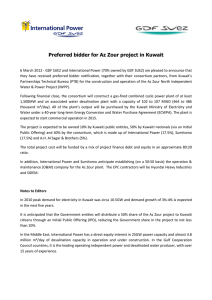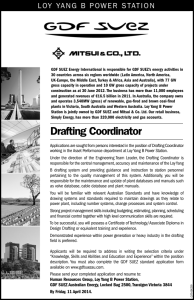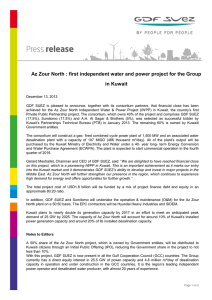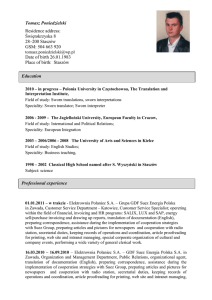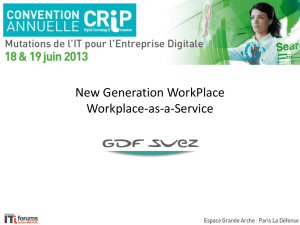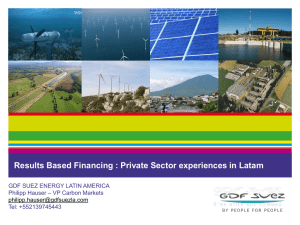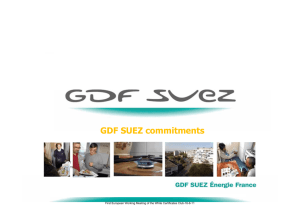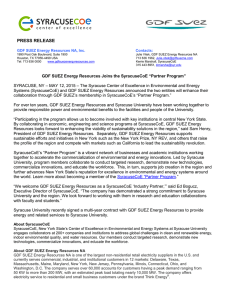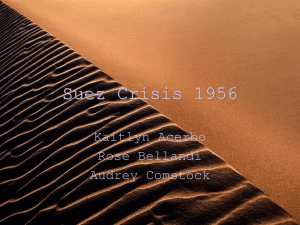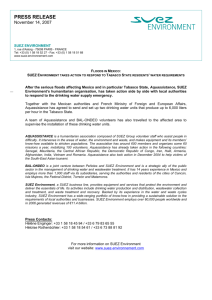GDF SUEZ and RIO+20
advertisement
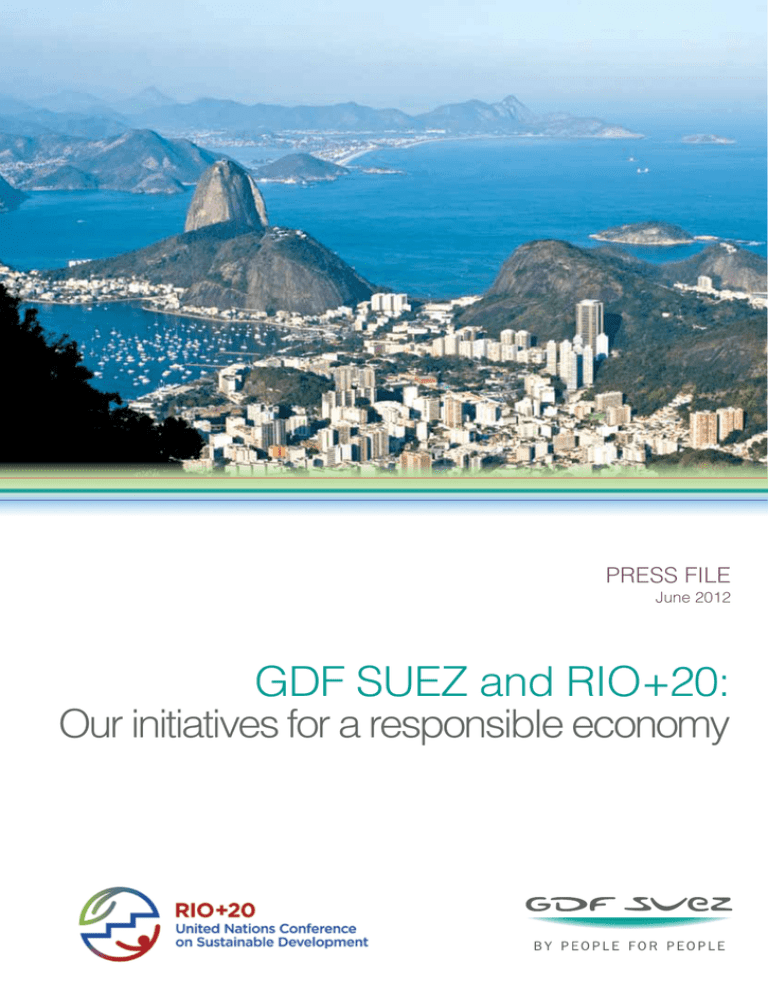
PRESS file June 2012 GDF SUEZ and RIO+20: Our initiatives for a responsible economy OUR INITIATIVES FOR A RESPONSIBLE GREEN ECONOMY The next Conference on Sustainable Development (Rio+20), organized by the United Nations, will be held in Rio de Janeiro, Brazil, on June 20-22. This event will be attended by government authorities at the highest level, as well as by many stakeholders from civil society. Rio+20 represents an opportunity for the private sector to clearly demonstrate its commitment to sustainable development. As the world’s largest utility, GDF SUEZ is an active participant in the mobilization around Rio+20. Backed by the business expertise of its 219,000 employees based in over 70 countries, GDF SUEZ makes responsible growth the focal point of its activities by offering innovative, sustainable solutions. GDF SUEZ relies on a diversified gas supply portfolio, flexible electrical power production facilities with low CO2 emissions, and unique expertise in four key sectors: liquefied natural gas, energy efficiency services, independent electricity generation, and environmental services. GDF SUEZ wishes to share all of the best practices developed within the Group with private customers, municipalities and businesses. Energy is essential to society’s development, and world consumption increased by over 5% in 2010, with CO2 emissions reaching their highest level ever. In 2010, 1.3 billion people did not have access to sustainable energy, and 2.7 billion had only traditional biomass available for food preparation. The development of an economy with low carbon emissions accessible to the greatest number of people is a critical factor in responsible growth over the long term. This commitment requires major efforts to control global warming and its impact on ecosystems, and innovative social initiatives to contribute to access to sustainable energy for all. The challenge of this new development model lies in implementing methods of production and the infrastructures necessary for growth while maintaining social and environmental stability. This is why GDF SUEZ is diligent in assuring that all three aspects of sustainable development - economic, social, and environmental - are integral parts of its strategy and the development of its activities. The Group also ascribes great importance to responding to the expectations of stakeholders and communities in its projects, from the initial design phase to construction and operation. This policy allows better integration of facilities into their localities, as well as value creation that is shared by the company and local players, in the form of business activity and jobs. As an energy Group with a major presence in emerging regions, where 80% of future energy needs are concentrated, GDF SUEZis focusing on specific initiatives to respond to critical energy and social needs. For example, to confront the specific problem of energy access for all, GDF SUEZ inaugurated its “GDF SUEZ Rassembleurs d’énergies” (“Energy Gatherers”) initiative in 2011. This measure aims to give access to energy to impoverished people in developing countries, while helping to overcome the lack of secure energy supplies in developed countries. The Group’s major projects are therefore targeted at promoting solutions that minimize the use of resources and facilitate people’s access to up-to-date, dependable, affordable, clean energy. This vision becomes a reality through the development of renewable energies, control of energy consumption, the choice of a circular economy, solutions for the city of tomorrow, and an innovative and determined approach to energy access for the most severely disadvantaged. Table of Contents TOWARDs NEW GROWTH MODELS: DEVELOPING THE GREEN ECONOMY 4 RENEWABLE ENERGIES4 ENERGY EFFICIENCY8 SMART GRIDS 11 A COMMITMENT TO SUSTAINABLE ENERGY ACCESS FOR ALL: GDF SUEZ RASSEMBLEURS D’éNERGIES 13 CONSERVING RESOURCES AND PRESERVING ECOSYSTEMS16 CITIES: IDEAL AREAS FOR TESTING ENVIRONMENTALLY AND SOCIALLY INNOVATIVE SOLUTIONS19 OPTIMIZING WATER AND ENERGY SOURCES22 Toward new growth models: developing the green economy Renewable energies The challenges for the GDF SUEZ Group: a sustainable energy mix Confronted with the challenges of controlling the energy market and limiting greenhouse gas emissions, GDF SUEZ made the decision to diversify its production facilities. This strategy was implemented by investment in renewable energies in all sectors, for both electricity generation (hydropower, biomass and biogas, wind and photovoltaic energy) and heating (biomass, solar and geothermal energy). At the end of 2011, GDF SUEZ had a total overall capacity of 21.7 GW, of which 16.1 GW were in operation. 4 Every day, our construction sites and investment projects take another step toward our goal of increasing this installed capacity by 50% in 2015 compared with 2009 levels. This is one of the Group’s ten sustainable development goals, which demonstrates the importance we attach to the development of clean energy that is respectful of the environment. The leadership position of GDF SUEZ in the renewable energies sector, particularly in France, and its many projects throughout the world are proof of this commitment. The Group has already increased its installed capacity of renewable energies by 20% since 2009. Local and international implementation With its five subsidiaries specializing in wind energy, GDF SUEZ stands out in France as the national leader in this sector with 16% of installed capacity. The Group has also developed several wind farms in Europe (Piano del Cornale in Italy and JarMoltowo in Poland), in Latin America (Monte Redondo in Chile), and in North America. In hydropower, Compagnie Nationale du Rhône (CNR) and Société Hydro Électrique du Midi (SHEM) make GDF SUEZ the 2nd largest French operator with over 25% of generation and more than 3,700 MW of installed power. The Group is also engaged in several hundred hydropower projects throughout the world (the Estreito and Jiraú dams in Brazil), a sector in which GDF SUEZ has been active for over 30 years. In addition to these two major renewable energy segments, construction is underway on biomass plants in the Netherlands, Belgium (the Rodenhuize plant was inaugurated in September 2011), and Poland. We are also actively contributing to structuring the wood-to-energy sector to assure high quality supplies over the long term. In addition, projects for exploiting geothermal resources are being studied in the southern part of the island of Sumatra. Finally, in the area of solar energy, the Group has begun developing facilities in France, Italy, and Portugal (the Ferreira do Alentejo and Porteirinhos plants). New photovoltaic installations have recently been inaugurated in France, notably the Bollène plant in the Vaucluse region. In addition to its activities in renewable energies, GDF SUEZ, in partnership with local authorities, is offering its expertise right in the heart of the city: in eco-districts, energy-saving buildings, installation of biomass heating plants and the operation of urban networks that limit CO2 emissions. Finally, the Group has created a subsidiary in France that is entirely dedicated to optimizing the operation of its renewable energy production units (except hydropower). Leadership in wind-powered energy (France) In January 2012, the Compagnie Nationale du Rhône inaugurated its 20th land-based wind farm in Guerville-Melleville, 15 kilometers from the shore of the English Channel. With 5 wind turbines, each with 2.3 MW of power, this facility will produce about 28,000 MWh a year, which will cover the electricity needs of approximately 10,000 households, excluding heating. This wind farm will reduce the amount of CO2 released into the atmosphere each year by 27,000 metric tons. Since the launch of the pilot study in 2002, CNR has focused on the importance of local relationships and respect for the environment (presentation of the project to the community’s residents, studies on the technical and environmental impacts, guaranteed income for the local economy, etc.). With the launch of this new project, developed with ENERGIETEAM, CNR crossed the threshold of 200 MW of installed wind power and allowed the GDF SUEZ Group to reach 1,000 MW (CNR and other subsidiaries specializing in wind power). This has helped GDF SUEZ to strengthen its leadership position in France. 5 Run-of-the-river hydropower plant in Jiraú (Brazil) GDF SUEZ attaches great importance to the development of renewable energies in Latin America, where numerous projects are underway. The Group strives to make optimal use of the resources available in the Brazilian countryside. The hydropower project in Jiraú, along the Madeira River, will use water resources to produce energy, targeting an installed capacity of 3,750 MW. This “run-of-the-river” plant has the advantage of a reduced impact on the environment and local inhabitants, with a relatively small reservoir for its maximum electricity generation capacity. The Jiraú project also includes social objectives, particularly targeting beneficial spin-off effects on the local economy (local job creation, improvement in nearby residents’ quality of life, protection of the environment etc.). GDF SUEZ has established 33 socio-economic and environmental projects that have been endorsed by the Brazilian government’s environmental agency, IBAMA, for a total sum of €520 million. These projects include a provision required when an environmental permit is obtained, such as social programs for environmental education, public health and protection of biodiversity. There is also a provision for voluntary partnerships with highly regarded NGOs. GDF SUEZ targets the highest possible socio-economic standards in its work in Jiraú, with compliance assured by external auditors. 6 New pilot biomass project in the Atacama Desert (Chile) The thermal plants of E-CL, a GDF SUEZ subsidiary, are located in northern Chile, a few kilometers from the Atacama Desert. E-CL decided to establish cactus and shrub plantations in this arid region to produce biomass to fuel its new CTA-CTH electricity production units with a renewable resource, replacing about 10% of the coal used in the two plants. This project has the advantage of producing biomass on land that is not suitable for agriculture or other uses, due to the aridity and salinity of the soil. Furthermore, the close proximity of the plantations and the plants (4 km) considerably reduces costs and CO2 emissions related to the transport of the resource. In addition to reducing the carbon footprint of E-CL, this project creates a new focus of development for the local community of Mejillones, by generating almost 200 new jobs and diversifying the region’s activities. 7 Wind farm in Monte Redondo (Chile) Located 325 km north of Santiago in the Coquimbo region, this new farm, which was inaugurated in 2009, is composed of 24 wind turbines, each with a capacity of 48 MW (Phase I: 19 turbines + Phase II: extension with the construction of 5 additional turbines in 2011). This project, backed by an investment of $127 million, strengthens the Group’s position in the Central Interconnected System (central and south Chile), one of the country’s two largest energy grids. It can supply clean energy to 74,000 households in this network, while reducing CO2 emissions by 88 million metric tons a year. Wind energy is an additional component in the policy of diversifying the GDF SUEZ energy portfolio in Chile, contributing to the stabilization of energy prices while reducing the Group’s dependence on fossil fuels. This wind farm allows the production of clean energy as well as establishing carbon credits, in compliance with the Clean Development Mechanism of the Kyoto Protocol. Energy efficiency Challenges for the GDF SUEZ Group: controlling energy consumption Implementation of a responsible growth policy compels us to consider how we should carry out our production and consumption activities Energy production and consumption are central to our social and environmental challenges: rising energy demand, scarcity of resources, and the fight against pollution and global warming. These challenges are central to the activities of GDF SUEZ as a major utility. It is therefore incumbent on the Group to offer the best solutions to consistently optimize the entire energy value chain, from generation through distribution, all the way to the end user. Energy efficiency and control of energy consumption are therefore at the center of the Group’s strategy and the products it offers in its many businesses, on several levels: • within its energy services, the Group designs, installs and operates facilities belonging to its customers (private customers, professionals, businesses and local authorities) to provide the required services while reducing energy consumption and greenhouse gas emissions. • as an energy supplier, the Group also operates its own energy generation and distribution facilities and assets. 8 • in its environmental services, improving energy efficiency is also part of the Group’s sustainable development commitment. Thus, SUEZ ENVIRONNEMENT is developing technologies that consume less energy, due primarily to the modernization of its water and waste treatment facilities and the optimization of its sludge incineration process. A comprehensive policy of energy services products The Energy Services Business Line of GDF SUEZ and its 76,000 employees offer multi-technical energy efficiency and environmental solutions. Through its brands, TRACTEBEL, INEO and COFELY, GDF SUEZ stands out in the fields of engineering, installation, and energy services. The energy suppliers within the GDF SUEZ Group (GDF SUEZ DOLCEVITA, GDF SUEZ ENERGIES FRANCE, and GLOBAL ENERGY brands) also carry out hundreds of thousands of energy saving initiatives annually for their customers. The Group is also investing in R&D to develop tomorrow’s technologies and optimize the operation of its facilities. This can be seen, for example, in the development of an array of power production units based on efficient facilities (such as CCGTs, wind, hydro, and cogeneration), experimenting with biomass gasification, and the development of innovative processes for heating such as micro-cogeneration for new generations of boilers or gas heat pumps. Sustainable solutions for major industrial customers (France) GDF SUEZ Global Energy conducted a feasibility study for the recovery of combustion gases from a galvanizing furnace at the Arcelor Mittal Atlantique Desvres site in France. After conducting expert assessments and measurements onsite, the GDF SUEZ Global Energy experts recommended the installation of a recovery boiler that uses combustion gases to preheat the treatment baths. Since the industrial site has implemented this solution, it has saved 15% on energy consumption and reduced its CO2 emissions by 2,600 metric tons per year and will earn back its investment in under two years. Optimization of public lighting and building renovation (France) With its old lighting fixtures and a high energy consumption school complex, the town of Bougival (France) wanted to improve the energy performance of its facilities while enhancing its existing assets. In 2011, INEO and COFELY were awarded a “mixed” Energy Performance Partnership Contract for the optimization of its public lighting fixtures and the renovation of its Claude Monet school complex to meet low-energy consumption standards. This is the first time that a contract of this kind has been signed in France. For a period of 20 years, this PPP also includes the operation and maintenance of all facilities. In total, the consumption by buildings will be reduced by 80% and the use of renewable energy will make it possible to decrease currently generated CO2 emissions by over 98%. 9 Renovation and performance of datacenter (Belgium) The Fortis BNP Paribas datacenter in Haren, Belgium, which was built in 1972, had an end of life scheduled for 2015. With a surface area of 5,500 m², the Tier III+ datacenter was renovated in 2008 by COFELY SERVICES, thus making it possible to improve the overall performance of the site significantly. Despite difficult conditions of performance, COFELY SERVICES improved datacenter performance by nearly 20% through cost-effective solutions (free cooling, outside temperature sensors on equipment, pooling of server capacities, reduced ventilation and moisture flow, etc.). 10 Smart grids Challenges for the GDF SUEZ Group: developing energy innovations The efforts to manage energy resources intelligently also include the optimization of grids and power consumption systems. For several years, GDF SUEZ has been launching projects and actions to advance thinking on “smart grids”. These networks of the future will be an essential tool in the transition to more fuel-efficient energy systems. Besides their ability to improve stability and reliability, smart grids will significantly change the nature of the energy supply and the relationship between energy suppliers and their customers. Study and development of smart grids Smart metering is the first link in the smart grid. In this area, Lyonnaise des Eaux is equipping French households with smart meters as concession contracts are renewed. GrDF and the French energy regulator are studying the deployment of 11 million communicating gas meters. ONDEO SYSTEMS, a Group subsidiary, has also built a highly effective smart metering solution for water and gas, which it is offering to the European grid. Finally, the Group’s business lines in charge of energy supply and services are jointly developing new products based on smart technologies that will make it possible for their customers to improve energy efficiency. The development of customized smart grid solutions includes the construction of demonstrators that make it possible to test technologies, study the behavior of consumers and their acceptance of proposed changes, and develop viable business models for offers. Smart grids thus makes it possible to adapt management to consumer behavior, through a network of electricity produced in a decentralized manner, a more dynamic equilibrium between electricity production and demand, and the development of sustainable solutions. GDF SUEZ is participating in a major project in Belgium, LINEAR, and in Greenlys, one of the largest smart grid demonstration projects in Europe, which has just been launched in Lyons and Grenoble. Finally, in the US and the UK, as well as France, the Group has already begun aggregation offers with its industrial customers, which involves the modulation of their customers’ load to help reduce consumption spikes. 11 GreenLys (France) The GreenLys project is a full-scale demonstrator (1,000 residential customers and 40 commercial sites in urban areas) that makes it possible to develop and test the technology solutions needed for the implementation of smart grid functionalities. GDF SUEZ, with a consortium of industrial and research partners (ERDF, GEG, Schneider, Alsthom, Grenoble-INP) and local authorities in Grenoble and Lyons, had responded to the Call for Expressions of Interest made by the ADEME agency regarding smart networks and power systems (Smart grids - Smart metering). After more than a year of preparation, the GreenLys project was approved by the local authorities through the favorable decision of the General Commission for Investment. For the experimental period of the project(between 2011 and 2014), GreenLys has several goals: identifying the technological and societal barriers and quantifying the sources of value related to the deployment of a smart electricity system; placing customers at the heart of the smart grid concept of and including them in the active management of electricity demand and production; and finally, building a global vision encompassing economic, industrial, environmental and societal goals. LINEAR (Belgium) 12 Local Intelligent Networks and Energy Active Regions (LINEAR), is a major stage in research into the construction and implementation of smart grids. It is the demonstrator project with the greatest visibility in Belgium. This project would make possible the large-scale deployment of smart meters in Belgium. LABORELEC, a GDF SUEZ research and skills center that specializes in electricity technologies, is contributing to this project by developing data collection and monitoring methods for field tests. LABORELEC has extensive expertise in the development of boilers and smart heat pumps and in the testing of concepts developed both in the laboratory and by assessing the impact of those intelligent applications on the quality of the low-voltage power grid. A commitment to sustainable energy access for all: GDF SUEZ Rassembleurs d’énergies Challenges for the GDF SUEZ Group: sustainable energy access for all In 2011, 1.3 billion people were without access to electricity. In Europe, one in four people live with fuel poverty. As a major energy group, GDF SUEZ is therefore particularly concerned with two major challenges: guaranteeing sustainable access to energy for everyone and combating fuel poverty. GDF SUEZ is convinced of the potential role of the private sector in development and poverty reduction. For this reason, GDF SUEZ has developed innovative models to support energy access projects for the poor. As a result, in 2011, the Group launched the GDF SUEZ Rassembleurs d’Energies initiative. The social dimension at the heart of an innovative initiative GDF SUEZ Rassembleurs d’Energies is an initiative with three complementary areas of action: • Donation, with the GDF SUEZ Corporate Foundation, which, through its Energies Solidaires program, provides support to NGOs and associations for public interest projects targeting energy access. • Technical assistance for projects, with the support of the three employee associations within the Group: Energy Assistance, Codegaz, and Aquassistance. • Finally, investment in projects led by corporate entrepreneurs through the creation of an investment fund. The purpose of the solidarity investment fund created by GDF SUEZ is to gradually reach €100 million, of which 10% will be immediately invested in energy access projects in the form of equity investments in corporate enterprises. Through its investment fund, GDF SUEZ Rassembleurs d’Energies aims to support viable, sustainable, and reproducable projects. They must have a strong social impact on local populations and encourage access to renewable or low GHG-emission energy sources, adapted to local environments. The concept of creating shared value is the key to this innovative initiative in which each stakeholder is a beneficiary of the project and its financial or social benefits. The initiative aims to support energy access projects in less developed countries or to reduce fuel poverty in developed countries. This initiative builds on a partnership approach, from the selection of the project to its funding and monitoring, with well known and complementary associations, NGOs, international institutions, or companies. 13 Energy access: support for the NGO Friendship (Bangladesh) FRIENDSHIP is an NGO that has been based in Bangladesh since 1998. It is led by Runa Khan, an iconic figure in social entrepreneurship. This NGO aims to provide essential services to the poorest and most marginalized populations in the country. The GDF SUEZ Foundation has been supporting FRIENDSHIP since 2010. Group volunteer experts are also working with NGOs on a project to bring electricity to island villages. These volunteers offer their technical expertise and work on solutions for these remote areas. 14 Decentralized energy solutions adapted to local needs (Peru) For the past three years, the NGO Energy Assistance France has been mobilizing the skills of GDF SUEZ employees to provide photovoltaic and micro-hydraulic energy to about twenty remote villages in Peru near the Brazilian border. After a field mission that identified needs and local resources, Energy Assistance France provided cocoa farmers in the villages of Pucalpillo and Santa Rosa with rechargeable solar energy lamps Fighting fuel poverty (France) The solidarity investment fund GDF SUEZ Rassembleurs d’Energies is supporting the development of La Foncière Chênelet. This project involves the construction of high energy performance public housing. The Foncière Chênelet charitable foundation specializes in the construction of high energy performance green public housing. It is building 70 public housing structures with the Low Consumption Building label for tenants who receive rental assistance loans. Raising awareness of energy savings (France) Since 2005, GDF SUEZ has been developing an ambitious program in France (ISIGAZ), which aims to raise awareness of energy savings and indoor gas appliance safety among public housing tenants in troubled urban areas. At the end of 2011, 680,000 people had benefited from these efforts, which were provided free of charge and conducted by social workers from more than 50 associations. 15 Conserving resources and preserving ecosystems Challenges for the GDF SUEZ Group: management of major water and waste cycles GDF SUEZ, through its subsidiary SUEZ ENVIRONNEMENT, is developing activities, solutions, and innovations for integrated management of the major water and waste cycles, and to conserve resources and preserve ecosystems and their services. 16 SUEZ ENVIRONNEMENT is enabling the recovery of household and industrial waste through the collection, sorting and effective preparation of waste. The Group also offers a wide range of services: from the material recovery of recyclable waste, to dismantling products at the end of life, and the production of high-quality secondary raw materials. The Group is an expert in the biological recovery of organic waste that can be turned into compost. Finally, SUEZ ENVIRONNEMENT produces energy from waste through different processes: incineration, biogas capture from landfills, and finally through the transformation of biodegradable waste into biogas by anaerobic digestion or composting. In addition, GDF SUEZ is committed to integrated management of the major water cycle in order to limit the impact of human activity on the resource. From the beginning of the cycle, solutions such as the protection of well fields are developed by the Group to protect the quality of the resource. SUEZ ENVIRONNEMENT is also developing services and tools that allow better quantitative management of water resources. For example, Lyonnaise des Eaux in France has a wide range of solutions for sustainable management of networks, which makes possible such actions as a reduction of network losses. In addition, SUEZ ENVIRONNEMENT is also developing the recovery of by-products from wastewater (sludge), which once processed and dried can be used as fuel. SUEZ ENVIRONNEMENT is working to optimize the hydrological mix through the use of alternative resources such as desalination of sea water, or wastewater reuse solutions for uses that do not require extensive water treatment, such as watering municipal parks or agricultural and industrial activities. Finally, the preservation of ecosystems is at the heart of the Group’s environmental businesses. SUEZ ENVIRONNEMENT is developing solutions, tools, and academic partnerships with trade associations and research programs for the restoration of the marine environment and preservation of aquatic and wetland areas, the rehabilitation of urban nature, or through the regeneration of biodiversity at landfills. Waste: an alternative energy source (UK ) SITA UK, a subsidiary of SUEZ ENVIRONNEMENT, is a leader in recycling and resource management in the UK. In November 2010, SITA UK signed an exclusive agreement with Cynar Plc, a company focused on new conversion technologies, to build ten factories to convert end-of-life plastic into diesel fuel, which will lead to the creation of about one hundred jobs. The SUEZ ENVIRONNEMENT venture capital fund will contribute to the funding mechanism, along with SITA UK. Each plant is designed to ensure the conversion of about 6,000 metric tons of mixed plastic waste per year, targeting specifically the waste that normally goes into landfills. Each is expected to produce over four million liters of diesel fuel from end-of-life plastic. This solution has a twofold advantage: it is useful for the environment and represents a new energy source. The cost of this diesel should also be less than normal diesel fuel and should have a lower carbon footprint than conventional diesel. Preserving the resource: producing water suitable for different types of uses (USA) For many years, the West Basin Water District (California) has faced a significant demand for water even though the water resources that came from Northern California and the Colorado River were rare. In 1995, the largest wastewater reuse program in the US was implemented in the region, and UNITED WATER, a subsidiary of SUEZ ENVIRONNEMENT, made a commitment to the West Basin Municipal Water District to increase the volume of wastewater reused, with the aim of replacing half of the imported potable water with recycled water, thereby reducing the use of potable water for industrial or agricultural purposes. As a result, five different qualities of water are produced each day to meet the needs of 300 users: water supplies to refineries such as Chevron and Exxon, groundwater recharge, irrigation of golf courses and parks, etc. 17 the “Libellule Zone” supporting biodiversity (France) Many studies have proven the depolluting virtues of natural environments. Working from such findings, Lyonnaise des Eaux decided to develop a novel supplementary treatment based on the concept of a biologically protected area known as the Libellule Zone* (Dragonfly Zone) to combat emerging pollutants. The purpose of these zones is to more effectively treat the outflow from sewage plants and fight emerging pollutants (pesticides, metals, medical residues) that escape standard wastewater treatment techniques while also improving local biodiversity. Rigorous scientific monitoring has been set up with frequent measurements of inflow and outflow to evaluate, over a 3-year period, the effective depolluting capacities of this 1.5-hectare zone and to monitor the development of biodiversity in the long term. 18 GrDF: a methodology for preserving biodiversity (France) In 2011, GrDF set out to develop a methodology to incorporate biodiversity preservation into its network projects (maintenance, extensions, renewals, etc.). This initiative is run as a joint construction project with CRIGEN, which is contributing its methodological expertise in environmental assessment, and with the French National Natural History Museum (MNHN) as part of a scientific partnership. The methodology is based on the principle “avoid, reduce and compensate”. It consists of constructing a methodology and a simple operational tool to take the living world into account in GrDF’s activities: its natural gas network projects. This software will give GrDF’s design and engineering planners the ability to determine whether they need to put in place a special action at any point to preserve biodiversity. Cities: ideal areas for testing environmentally and socially innovative solutions The challenge for GDF SUEZ Group: to help build the city of tomorrow In developing its activities, GDF SUEZ needs to tackle various social and environmental challenges such as demographic growth, climate change and the need for greater energy efficiency. As an urban development player, our Group strives to come up with new concepts of urban living in order to offer a range of solutions for sustainable urban development. The values of a sustainable city reflect its capacity to adapt and transform itself - over time - to offer high quality of life and practicality, energy saving buildings, smooth networks, security, and shared spaces. GDF SUEZ is committed to implementing these values by focusing on them right from the preparation stages of major urban projects. The GDF SUEZ approach to sustainable urban development Listening attentively and respectfully to the various stakeholders, striving to achieve a balance between human intervention and appropriate technologies in the region, transparency of information on environmental performance, and developing offers tailored to the local context are the principles underlying the Group’s approach to sustainable urban development. GDF SUEZ has proposed many sustainable development solutions for the city of tomorrow: • pooling the means of producing heat and cold, and a more efficient and less polluting central plant, • electricity and heat supply using “clean” production systems: photovoltaic panels, solar thermal panels, rooftop wind turbines, natural gas or electric heat pumps, geothermal sources, biomass, heat recovery from air venting from buildings, • heat recovery from wastewater, • methanization of household waste, offering a renewable source of energy to produce heat and electricity, • pneumatic waste collection, where the waste becomes publicly invisible, avoiding pollution including noise pollution and thereby improving the quality of people’s lives, • a dedicated secure network for virtual flows (data, voice and images). 19 Urban cooling network to meet Paris’s climate plan targets (France) CLIMESPACE has obtained a concession from the City of Paris until 2021 to meet the municipality’s climate plan targets. CLIMESPACE is specifically tasked with producing ice water to supply the 70-kilometer cooling network that provides cooling for 500 customers including public and cultural buildings (the Louvre, National Assembly, etc.), large stores and malls (Forum des Halles, Galeries Lafayette, etc.), as well as offices, hotels and palaces. The results obtained show a 30-50% reduction in energy consumption, a 40% reduction in CO2 emissions, a 65% reduction in water consumption, and an 80% reduction in the use of chemicals. 20 A power plant and a heating & cooling network for London’s Olympic Park (United Kingdom) To host the 2012 Olympic Games (10,000 athletes and millions of spectators expected) the City of London has redeveloped more than 300 hectares located near its City district. It has used the site to build the Olympic Park which, right from the start, embodies an ambitious sustainable development and environmental protection policy. GDF SUEZ has built and will operate the new ultra-modern trigeneration power plant which will use low-CO2-emission renewable sources (natural gas and biomass) to simultaneously produce heating, cooling and electricity. It will thus provide an efficient and low-carbon heating and air conditioning system for the Olympic Park, and thereafter for the new buildings and infrastructures in five “sustainable” districts of Greater London (Stratford) which will see the light of day after 2012. Emblematic of London’s commitment to “clean” Olympic Games, this energy plant as well as the urban network of the Olympic Park itself and the new “sustainable” districts, have been designed, financed and built by COFELY, a GDF SUEZ subsidiary. The Group will operate them for 40 years. To date, it is the largest project of its kind in the United Kingdom. Sludge recycling in Shanghai (China) SUEZ ENVIRONNEMENT has developed a method for processing the sludge from wastewater treatment facilities serving 610,000 people, with a processing capacity of 300 metric tons an hour. This process recovers the energy released in treating the sludge, using safe reliable technology. The resulting dried sludge can be used as fuel in the site’s electricity power plants, thereby helping to reduce coal consumption. The entire sludge recycling cycle is CO2 neutral. 21 Optimizing water and energy sources The challenge for the GDF SUEZ Group: combating the increasing scarcity of resources GDF SUEZ has many challenges to tackle, in particular the scarcity of natural resources, which means having to develop innovative and sustainable energy solutions. There are unbreakable links between water and energy. Water is necessary for energy production, and energy is needed to produce water. As a player in both the energy and water treatment industries, GDF SUEZ proactively participates in discussions and actions in water resource management. Indeed, optimizing water resource management forms part of the Group’s environmental policy and remains one of its priority actions for the years ahead. 22 Optimizing the use of water resources To better manage water resources, GDF SUEZ is working to more clearly understand the water footprint of its energy and water activities. Alongside this, it is focusing on implementing local action plans in areas suffering water scarcity or water stress. Some of the Group’s companies have already identified substantial water savings achievable at electricity power plants. In addition, as part of its constant focus on progress while at the same time working on its water footprint initiatives, GDF SUEZ is also improving its understanding of water consumption by adapting its reporting. To do this, the Group uses risk analysis tools such as the Global Water Tool developed by the World Business Council for Sustainable Development (WBCSD). The Group’s thinking, discussions and actions also extend to the diversification of energy sources, in particular the use of water as a means of producing green energy. This type of energy can be produced, for example, by recovering the heat in wastewater, or using dry sludge and biogas from sludge digestion as fuel in power plants. The Group is also continually looking for ways to improve the energy efficiency of its water infrastructures (wastewater treatment plants, for example). Last but not least, GDF SUEZ participates in world class initiatives and projects, such as the “Water Project” sponsored by the World Business Council for Sustainable Development (WBCSD), the CEO Water Mandate project, and the various projects of the World Water Forum, the most recent edition of which was held in Marseilles in March 2012. Minimizing the impact on water resources in gas exploration-production (Norway) GDF SUEZ, through its Global Gas & LNG Business Line, is particularly careful to minimize the impact of its oil & gas exploration and production activities on water resources. Its concern is illustrated by numerous initiatives implemented in its exploration-production activities. At the Gjøa offshore natural gas production platform in Norway, GDF SUEZ E&P Norge AS, a GDF SUEZ subsidiary, has highly efficient equipment to treat the process water associated with the crude oil & gas flowing from the wells. Although the threshold imposed by Norwegian standards for the quality of water released into the natural environment is a maximum of 30 mg of hydrocarbons per liter of water, GDF SUEZ E&P’s desire to be among the cleanest operators has led it to set its own target at half that figure, 15 mg/liter. GDF SUEZ E&P Norge AS is conducting R&D work with Biota Guard, a young Norwegian service company which is developing a solution to monitor and control the quality of the marine environment. Biota Guard offers, among other solutions, a system to detect hydrocarbon leaks and an environmental footprint assessment based on a technology that uses mussels as biological sensors. 23 Reducing water consumption in electricity generation (Brazil) TRACTEBEL ENERGIA, a GDF SUEZ subsidiary, develops numerous energy activities in Brazil aimed at protecting the environment. Through its Environmental Code, TRACTEBEL ENERGIA is developing sustainable and innovative solutions, specifically to preserve water resources using a range of different processes. TRACTEBEL ENERGIA is currently focusing on a system for using water infiltration in its hydropower plants. The Machadinho Hydropower plant is one of the two facilities that use this system of water infiltration from rock formations. This system reduces water use by sewage plants, removes the solid residue resulting from water treatment and curbs the use of chemicals. TRACTEBEL ENERGIA is also developing a closed cycle system to extract water from wet ash at the Jorge Lacerda coal-fired plant. The project to connect the wet ash extraction system has reduced the industrial use of water by 95% across the three units that make up the plant. 24 An autonomous-energy wastewater treatment plant (Jordan) The first in the Middle East, the contract between the Samra Plant Company (SPC), created by SUEZ ENVIRONNEMENT, Infilco Degrémont Inc., The Morganti Group Inc. and the Jordanian government represented by the Ministry of Water and Irrigation, is to design, finance, build and operate the As Samra wastewater treatment plant for 22 years. Designed to treat the wastewater from 2.2 million people in Greater Amman, the wastewater sewage plant implements technically advanced solutions for treating water as well as for treating sludge. Fully integrated into its environment, the plant is virtually autonomous in energy thanks to connecting its water turbines to gas-powered motors fuelled by the biogas from sludge digestion. This mechanism generates 95% of the electricity needed for water treatment, and reduces to 5% the proportion of power coming from the national grid. 25 drive commitment daring cohesion Tour T1 - 1 place Samuel de Champlain Faubourg de l’Arche 92 930 Paris La Défense cedex - France Communications and Financial Communications Division Press Service: Phone: + 33 (0) 1 44 22 24 35 www.gdfsuez.com
